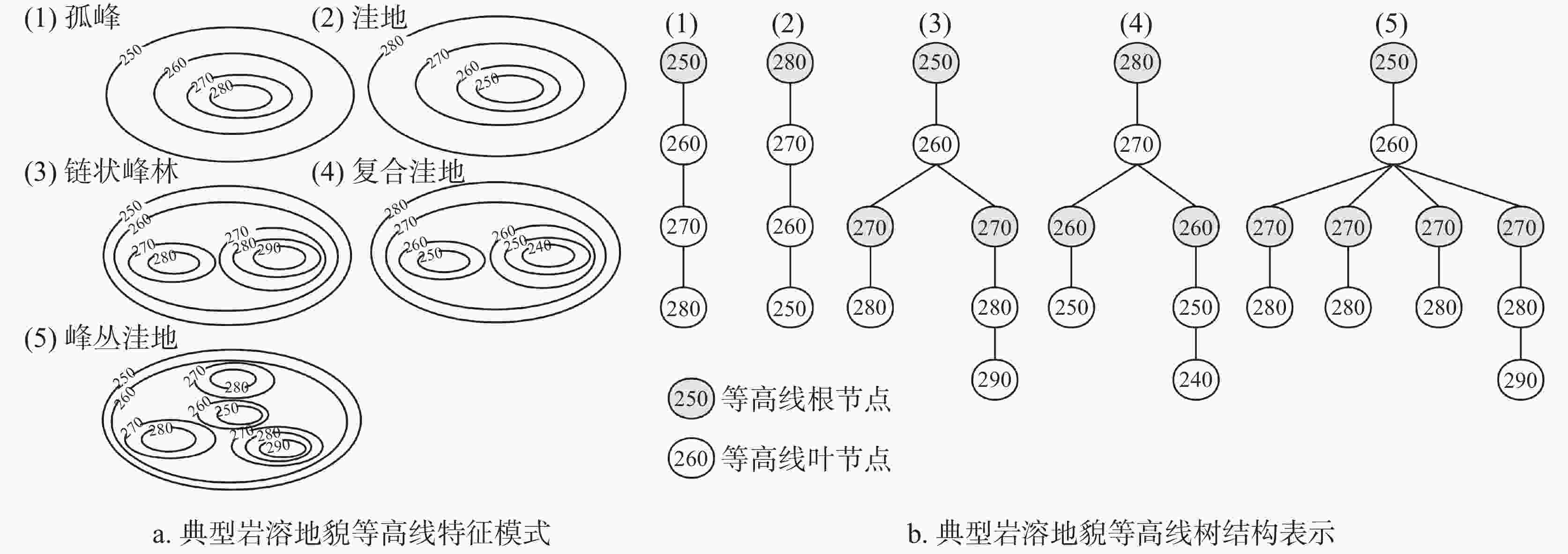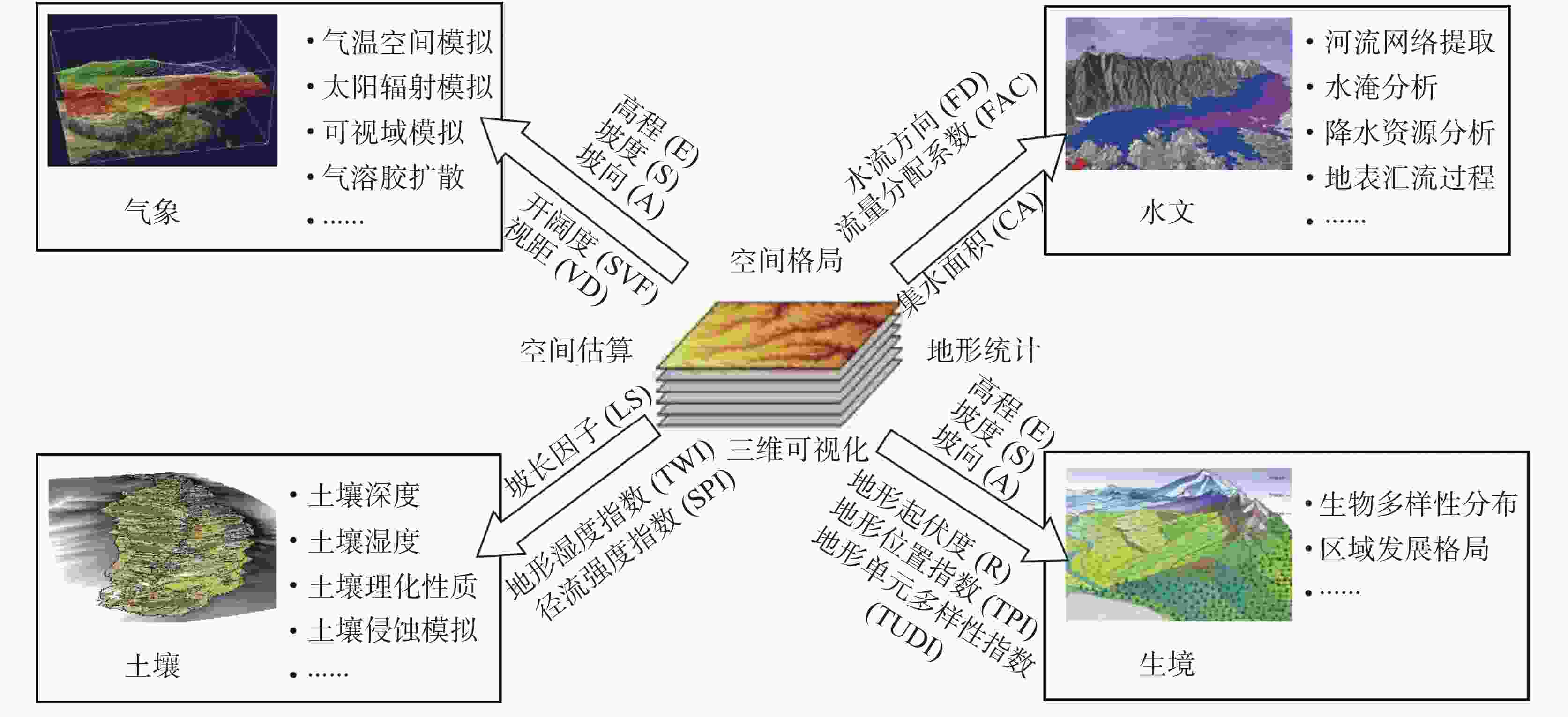Research progress and prospect of karst geomorphology in China based on digital elevation model
-
摘要: 数字高程模型(DEM)蕴含丰富的地形地貌信息,基于DEM的数字地形分析方法为岩溶地貌研究提供了科学、有效的技术手段。文章针对前人应用DEM研究中国岩溶地貌所涉及的关键技术方法,从岩溶地貌识别的尺度效应、岩溶地貌的识别与分类、岩溶地貌的形态及格局分析、岩溶区生态环境变化等方面进行了梳理和分析,提出未来应构建科学的岩溶地貌数字分类体系,对岩溶地貌进行多尺度、深层次的地形分析和定量表达,并从地形现状研究拓展到地形演变的过程与机理研究,发掘出DEM在岩溶地貌研究中更多的应用。Abstract: Digital elevation model (DEM) contains rich morphological information because the process of digital terrain modeling and extracting a series of terrain parameters based on DEM data with various spatial resolutions, known as Digital Terrain Analysis (DTA), has achieved a number of advances in topographic analysis, morphological modeling, distribution patterns and evolution patterns of karst landforms. This paper summarizes the new progress in spatial analysis of DEM based on the key technical methods of applying DEM to the previous Chinese studies on karst landform in recent years. The future research of DEM in karst geomorphology is also predicted in order to expand its application and provide technical ideas for the study of karst geomorphology from topology to the process and mechanism of topographic evolution.In this study, the applicability of the data model and the method of determining the optimal scale of analysis are discussed. Both DEM and DTA are obviously scale-dependent, and it is indisputable that the slope scales, watershed scales, and regional scales of karst topography require different resolution of DEM. Higher spatial resolution does not necessarily guarantee better automatic karst detection. Therefore, the main features of regional topography must be considered. When local terrain parameters are calculated and extracted, determining an optimal analysis window is necessary to reflect the completeness of the landform and guarantee the representativeness of calculation results.For the identification and classification of karst landforms, four effective methods for automatic extraction of karst landform units with DEM data and the advantages and disadvantages of these methods are analyzed. These methods are respectively based on cell statistics of composite factors, the extraction of terrain feature points, contour trees, and positive and negative topography. The first method is to divide the study area into a series of grids, calculate the topographic attributes of each cell grid, and construct an identification model including the establishment of peak forests, peak clusters and other karst geomorphic units. The second one is to construct a spatial relationship model of terrain feature points of different geomorphic units, and then automatically extract these units. The third one is to extract geomorphic contour lines by building a contour line recognition model for classification. The fourth one can reduce and simplify the complex and diverse terrains into positive and negative terrains to effectively highlight the morphological differences, and then divide them according to the characteristics of geomorphic units such as peak forests, peak clusters, etc.As for the morphology and pattern analysis of karst landform, the typical index parameters used to characterize the spatial pattern of karst landform are sorted out. In addition, the main applications of DEM in the ecological environment of karst area have been outlined. DEM can be used for topographic statistics, spatial pattern, spatial estimation and 3D visualization of meteorology, hydrology, soil and habitat, and then for the analysis of ecological environment changes in karst areas.However, the present classification system of karst landform is mainly focused on abstract expression and qualitative description, which can hardly quantify the detailed information of spatial structure of karst landform. This kind of system also cannot meet the demand of digitalization and intellectualization. In addition, with good recognition effect, the current methods for morphological and quantitative expression of karst landform have been widely applied to typical karst landforms such as peak forests, peaks and depressions. But for atypical karst landforms, DTA has rarely been tried.In conclusion, the prospective direction of DEM-based karst geomorphology research has been proposed in this study. First of all, a more effective quantitative classification system needs to be constructed for karst geomorphology and its topographic elements. A digital indicator system of karst geomorphology should be established to describe its spatial and geological properties in terms of spatial distribution relationships, change patterns, etc. Secondly, more comprehensive geomorphological information should be extracted from regional, watershed and slope scales to reveal the relationship between each indicator and karst development in the study on mechanism and evolution of karst development. Moreover, it is necessary to integrate remote sensing with other multi-source data to enrich the geological attributes of DEM and to delve into more information in soil, vegetation, geological structure and other fields.
-
Key words:
- karst geomorphology /
- digital elevation model /
- digital terrain analysis /
- progress
-
图 1 尺度效应的定量刻画曲线示例 [15]
Figure 1. Examples of curves for quantifying the scale effects in DTA
(a. scale effect with resolution change; b. scale effect with neighborhood size change)
表 1 峰林、峰丛岩溶地貌的形态指数特征
Table 1. Morphological characteristics of peak forest and peak cluster
测度 形态指数 峰林、峰丛地貌与一般非岩溶地貌对比 垂向测度 高程 峰林高度较低,一般几十到两百米;峰丛高度通常在两三百米以上,最大可达六百米以上 起伏度 峰丛地表粗糙,高程起伏相对变化大 水平测度 邻近性 峰丛具均匀的峰洼分布,峰林零星分布 隔离性 峰丛具孤立的洼地和互相连通的峰体 形状测度 地形表面积 峰丛具较大的地表面积,峰林具较小的地表面积 形状指数 峰丛岩溶地区由高频率的简单形态山体构成,形状指数小;非岩溶地貌一般由低频率的复杂形态山体构成,形状指数大 垂向和水平测度 坡度 峰林、峰丛地貌较一般丘陵坡度更大,峰丛坡度一般大于30°,峰林坡度一般大于45° 特征要素 山顶点/洼地点 峰丛山顶点和洼地点密集且相间均匀分布 鞍部点 峰林无明显鞍部点,峰丛有鞍部点且在一定范围内鞍部点围绕洼地点 山脊线和山谷线 非岩溶地貌通常由山脊和山谷组成,山脊的海拔会逐渐下降到山谷,如果断面恰好沿着山脊线或谷底,则减少得更慢 表 2 可用于表征岩溶地貌空间格局的典型指标参数[35, 39-40]
Table 2. Typical index parameters used to characterize the spatial pattern of karst landscape
类别 量化因子 计算公式 备注 地学意义 形态统计特征 坡度 $ \beta = \arctan \sqrt {f_x^2 + f_y^2} $ 式中:fx是X方向高程变化率;fy是Y方向高程变化率 反映地表面在该点的倾斜程度 粗糙度 $ {\text{R}} = {S_s}/{S_p} = 1/\cos (\tan \beta ) $ 计算地表的曲面面积Ss与其在水平面上的投影面积Sp之比;tanβ为DEM栅格单元坡度 反映地表的起伏变化和侵蚀程度的指标 复合地形指数 ${{CTI} } = In(\alpha /\tan \beta )$ 式中:α 表示单位等高线长度的汇水面积;tanβ为该处的坡度;CTI又称地形湿度指数TWI 对径流路径长度、产流面积等的定量描述,也可反映地形的复杂性 分形维数 $ {{\text{F}}_{\text{d}}} = - \log N(\varepsilon )/\log \varepsilon $ 式中:ε为栅格格网边长大小;N(ε)为栅格总数 表征不同地貌类型下峰体形态的自组织程度 空间展布特征 形状指数 $ S = \displaystyle\sum\limits_{i = 1}^N {{W_i}} \dfrac{{{P_i}}}{{2\sqrt {\pi {A_i}} }} $ 式中:N为该地区总斑块个数;Wi为第i个斑块的面积权重;Pi为第i个斑块周长;Ai为第i个斑块面积 反映地貌单元景观斑块在空间结构上的不规则程度 邻近指数 $ PI = \displaystyle\sum {({{{a_j}} / {h_{ij}^2}})} $ 式中:aj表示斑块面积;hij表示斑块ij到同类型斑块的最近距离 可表征峰洼之间的隔离趋势 莫兰指数 $ I = \dfrac{{\displaystyle\sum\limits_{i = 1}^n {\displaystyle\sum\limits_{j = 1}^m {[ {( {{x_i} - {x_m}} )( {{x_j} - {x_m}} )} ]} } }}{{\displaystyle\sum\limits_{i = 1}^n {{{( {{x_i} - {x_m}} )}^2}} }} $ 式中:xi和xj分别为在位置i、j的测量值;xm是所在所有i、j位置点测量值的均值;n为所有测量点的数目 反映地貌景观斑块在空间上的集聚程度 地貌发育
演化特征峰洼密度 $ D = \dfrac{{{N_p} + {N_s}}}{A} $ 式中:Np为样区内峰顶个数;Ns为样区内洼地个数;A为样区的面积 表示峰体洼地的聚集程度,侧面反映岩溶发育程度 面积-积分值 $ {E_i} = \dfrac{{\displaystyle\int_0^H {adh} }}{{HA}} = \displaystyle\int_0^1 {xdy} $ 式中:a表示水平断面面积;h是等高线的相对高程值;H是样区的高差;A是样区的面积 通过构建不同等高线上的面积和相对高差之间的函数关系来评价地貌演化阶段和侵蚀动力差异 -
[1] 袁道先. 中国岩溶学[M]. 北京: 地质出版社, 1994.YUAN Daoxian. Karst Science in China[M]. Beijing: Geological Publishing House, 1994. [2] Ford D, Williams P. Karst hydrogeology and geomorphology[M]. London: John Wiley & Sons, 2007. [3] Yamazaki D, Ikeshima D, Tawatari R, Yamaguchi T,O'Loughlin F,Neal J C,Sampson C C,Kanae S,Bates P D. A high-accuracy map of global terrain elevations[J]. Geophysical Research Letters, 2017, 44(11):5844-5853. doi: 10.1002/2017GL072874 [4] 汤国安, 那嘉明, 程维明. 我国区域地貌数字地形分析研究进展[J]. 测绘学报, 2017, 46(10):1570-1591. doi: 10.11947/j.AGCS.2017.20170388TANG Guoan, NA Jiaming, CHENG Weiming. Progress of Digital Terrain Analysis on Regional Geomorphology in China[J]. Acta Geodaetica et Cartographica Sinica, 2017, 46(10):1570-1591. doi: 10.11947/j.AGCS.2017.20170388 [5] 汤国安, 李发源, 熊礼阳. 黄土高原数字地形分析研究进展[J]. 地理与地理信息科学, 2017, 33(4):1-7. doi: 10.3969/j.issn.1672-0504.2017.04.001TANG Guoan, LI Fayuan, XIONG Liyang. Progress of Digital Terrain Analysis in the Loess Plateau of China[J]. Geography & Geo-Information Science, 2017, 33(4):1-7. doi: 10.3969/j.issn.1672-0504.2017.04.001 [6] Minár J, Evans I, Krcho J. Geomorphometry: Quantitative Land-Surface Analysis[J]. Treatise on Geomorphology, 2013, 14:22-34. [7] 李振洪, 李鹏, 丁咚, 王厚杰. 全球高分辨率数字高程模型研究进展与展望[J]. 武汉大学学报(信息科学版), 2018, 43(12):1927-1942.LI Zhenhong, LI Peng, DING Dong, WANG Houjie. Research Progress of Global High Resolution Digital Elevation Models[J]. Geomatics and Information Science of Wuhan University, 2018, 43(12):1927-1942. [8] 唐新明,李世金,李涛,高延东,张书毕,陈乾福,张祥. 全球数字高程产品概述[J]. 遥感学报, 2021, 25(1):167-181.TANG Xinming, LI Shijin, LI Tao, GAO Yandong,ZHANG Shubi,CHEN Qianfu,ZHANG Xiang. Review on global digital elevation products[J]. National Remote Sensing Bulletin, 2021, 25(1):167-181. [9] 胡加佩, 关小荣, 刘学军. 中国区域SRTM DEM与ASTER GDEM误差空间分布特征[J]. 地理与地理信息科学, 2017, 33(4):28-33. doi: 10.3969/j.issn.1672-0504.2017.04.005HU Jiapei, GUAN Xiaorong, LIU Xuejun. Spatial Distribution of SRTM DEM and ASTER GDEM Error in China[J]. Geography & Geo-Information Science, 2017, 33(4):28-33. doi: 10.3969/j.issn.1672-0504.2017.04.005 [10] 黄平, 张行南, 徐涛, 郭乐,王祥. 常用免费DEM数据质量分析[J]. 南水北调与水利科技, 2016, 14(2):75-81.HUANG Ping, ZHANG Xingnan, XU Tao, GUO Le,WANG Xiang. The analysis of the suitability of Commonly Used DEM data[J]. South-to-North Water Diversion and Water Conservancy Science & Technology, 2016, 14(2):75-81. [11] 王青, 李阳兵, 李卫海, 丹文丽. 喀斯特地形对DEM精度的响应: 以清镇王家寨地区为例[J]. 贵州师范大学学报:自然科学版, 2010, 28(2):17-19.WANG Qing, LI Yangbing, LI Weihai, DAN Wenli. A response of DEM accuracy to karst topography - case study of Wangjiazhai village in Qingzhen city[J]. Journal of Guizhou Normal University ( Natural Sciences), 2010, 28(2):17-19. [12] 山克强. 基于数字高程模型的岩溶地貌类型划分: 以1∶5000西南岩溶区地质填图试点为例[J]. 中国岩溶, 2021, 40(2):334-345.SHAN Keqiang. Landscape classification in karst areas based on DEM: A case study of 1∶50, 000 pilot geological mapping of karst areas in southwestern China[J]. Carsologica Sinica, 2021, 40(2):334-345. [13] Kakavas M, Nikolakopoulos K G, Kyriou A, Zagana H. Assessment of freely available DSMs for automatic karst feature detection[J]. Arabian Journal of Geosciences, 2018, 11(14):388. doi: 10.1007/s12517-018-3654-8 [14] 呼雪梅, 秦承志. 数字地形分析中适宜分析窗口选择方法的评价[J]. 武汉大学学报(信息科学版), 2017, 42(10):1365-1372.HU Xuemei, QIN Chengzhi. Analysis on the Approach to Determine an Appropriate Window Size for Grid-Based Digital Terrain[J]. Geomatics and Information Science of Wuhan University, 2017, 42(10):1365-1372. [15] 秦承志, 呼雪梅. 栅格数字地形分析中的尺度问题研究方法[J]. 地理研究, 2014, 33(2):270-283. doi: 10.11821/dlyj201402007QIN Chengzhi, HU Xuemei. Review on scale-related researches in grid-based digital terrain analysis[J]. Geographical Research, 2014, 33(2):270-283. doi: 10.11821/dlyj201402007 [16] 曹伟超, 陶和平, 孔博, 刘斌涛,孙玉莲. 基于DEM数据分割的西南地区地貌形态自动识别研究[J]. 中国水土保持, 2011(3): 38-41.CAO Weichao,TAO Heping,KONG Bo,LIU Bintao,SHUN Yulian.Research on automatic recognition of landform morphology in southwest China based on DEM data segmentation[J]. Soil and Water Conservation in China, 2011(3): 38-41. [17] 赵宇鸾, 李秀彬, 张颖. 黔桂喀斯特山地与山区类型划分技术与应用[J]. 地球信息科学学报, 2017, 19(7):934-940.ZHAO Yuluan, LI Xiubin, ZHANG Ying. Technology and Application of Mountainous Area Divisions in Qian-Gui Karst Areas[J]. Journal of Geo-Information Science, 2017, 19(7):934-940. [18] 孟欣. 基于DEM的峰丛区岩溶洼地提取与形态特征分析[D]. 南京: 南京师范大学, 2019.MENG Xin. Extration and Morphological Charateristics Analysis of Karst Depressions in Fengcong Area Based on DEMs[D]. Nanjing: Nanjing Normal University, 2019. [19] 程维明, 周成虎, 李炳元, 申元村. 中国地貌区划理论与分区体系研究[J]. 地理学报, 2019, 74(5): 839-856.CHENG Weiming, ZHOU Chenghu, LI Bingyuan,SHEN Yuancun. Geomorphological regionalization theory system and division methodology of China. Acta [J] Geographica Sinice, 2019, 74(5): 839-856 [20] 马士彬, 安裕伦. 基于ASTER GDEM数据喀斯特区域地貌类型划分与分析[J]. 地理科学, 2012, 32(3):368-373.MA Shibin, AN Yulun. Auto-classification of Landform in Karst Region Based on ASTER GDEM[J]. Scientia Geographica Sinica, 2012, 32(3):368-373. [21] Liang F, Xu B. Discrimination of tower-, cockpit-, and non-karst landforms in Guilin, Southern China, based on morphometric characteristics[J]. Geomorphology, 2014, 204:42-48. doi: 10.1016/j.geomorph.2013.07.026 [22] 薛显武, 陈喜, 张志才, 秦年秀. 基于地形因子特征值的喀斯特流域地貌类型判别[J]. 中国岩溶, 2009, 28(2):175-180. doi: 10.3969/j.issn.1001-4810.2009.02.012XUE Xianwu, CHEN Xi, ZHANG Zhicai, QIN Nianxiu. Categorization of karst landform on the basis of landform factor eigenvalue[J]. Carsologica Sinica, 2009, 28(2):175-180. doi: 10.3969/j.issn.1001-4810.2009.02.012 [23] Zhao W, Xiong L, Ding H, Tang G. Automatic recognition of loess landforms using Random Forest method[J]. Journal of Mountain Science, 2017, 14(5):885-897. doi: 10.1007/s11629-016-4320-9 [24] Yang X, Tang G, Meng X, Xiang L. Saddle Position-Based Method for Extraction of Depressions in Fengcong Areas by Using Digital Elevation Models[J]. ISPRS international journal of geo-information, 2018, 7(4):136. doi: 10.3390/ijgi7040136 [25] Yang X, Tang G, Meng X, Xiang L. Classification of Karst Fenglin and Fengcong Landform Units Based on Spatial Relations of Terrain Feature Points from DEMs[J]. Remote Sensing, 2019, 11(16):1950. doi: 10.3390/rs11161950 [26] Liang F, Du Y, Ge Y, Li C. A quantitative morphometric comparison of cockpit and doline karst landforms[J]. Journal of Geographical Sciences, 2014, 24(6):1069-1082. doi: 10.1007/s11442-014-1139-6 [27] Wu Q, Deng C, Chen Z. Automated delineation of karst sinkholes from LiDAR-derived digital elevation models[J]. Geomorphology, 2016, 266:1-10. doi: 10.1016/j.geomorph.2016.05.006 [28] Meng X, Xiong L, Yang X, Yang B,Tang G. A terrain openness index for the extraction of karst Fenglin and Fengcong landform units from DEMs[J]. Journal of Mountain Science, 2018, 15(4):752-764. doi: 10.1007/s11629-017-4742-z [29] Yokoyama R, Shirasawa M, Pike R J. Visualizing topography by Openness: A new application of image processing to digital elevation models[J]. Photogrammetric Engineering & Remote Sensing, 2002(3):257-265. [30] 李婧昕, 许尔琪. 中国西南喀斯特地区正负地形的提取方法研究[J]. 资源科学, 2017, 39(10):1989-1999.LI Jingxin, XU Erqi. Extraction of positive and negative terrain boundary in Karst region of Southwest China[J]. Resources Science, 2017, 39(10):1989-1999. [31] Li J, Zhang H, Xu E. A two-level nested model for extracting positive and negative terrains combining morphology and visualization indicators[J]. Ecological Indicators, 2020, 109:105842. doi: 10.1016/j.ecolind.2019.105842 [32] 张磊. 基于核心地形因子分析的黄土地貌形态空间格局研究[D]. 南京: 南京师范大学, 2013.ZHANG Lei. Study on the spatial pattern of loess landform based on core terrain factor analysis[D]. Nanjing: Nanjing Normal University, 2013. [33] 仲伟敬, 邢立新, 潘军, 王婷,王凯,张文哲. 基于DEM数据的地貌类型快速划分系统研究[J]. 吉林大学学报(信息科学版), 2018, 36(5):516-524.ZHONG Weijing, XING Lixin, PAN Jun, WANG Ting,WANG Kai,ZHANG Weizhe. Study on Fast Partitioning System of Geomorphic Types Based on DEM Data[J]. Journal of Jilin University (Information Science Edition), 2018, 36(5):516-524. [34] 朱德浩. 桂林地区峰丛洼地的形态量计及其演化[J]. 中国岩溶, 1982, 1(2):50-57.ZHU Dehao. Evolution of peak cluster-depression in Guilin area and morphometric measurement[J]. Carsologica Sinica, 1982, 1(2):50-57. [35] 杨先武. 基于DEM的喀斯特峰林峰丛地形特征与空间分异研究[D]. 南京: 南京师范大学, 2019.YANG Xianwu. DEM Based Research on the Topographic Characteristics and Spatial Variation of Fenglin and Fengcong Karst landforms[D]. Nanjing: Nanjing Normal University, 2019. [36] 胡章喜, 沈继方. 岩溶形态系统的分形特征及其机理探讨[J]. 地球科学, 1994, 19(1):102-107.HU Zhangxi, SHEN Jifang. Study on fractal charateristics of karst morphology system and its mechanism[J]. Earth Science-Journal of China University of Geosciences, 1994, 19(1):102-107. [37] Pardo-Igúzquiza E, Dowd P A. Fractal Analysis of Karst Landscapes[J]. Mathematical Geosciences, 2020, 52(4):543-563. doi: 10.1007/s11004-019-09803-x [38] 李玉辉, 丁智强, 吴晓月. 基于Strahler面积-高程分析的云南石林县域喀斯特地貌演化的量化研究[J]. 地理学报, 2018, 73(5):973-985. doi: 10.11821/dlxb201805015LI Yuhui, DING Zhiqiang, WU Xiaoyue. A quantitative study on the karst geomorphic evolution of Shilin county in Yunnan province of China based on Strahler hypsometric analysis[J]. Acta Geographica Sinica, 2018, 73(5):973-985. doi: 10.11821/dlxb201805015 [39] Schillaci C, Braun A, Kropáček J, Terrain analysis and landform recognition[M]. London: British Society for Geomorphology, 2015. [40] Straumann R. Extraction and characterisation of landforms from digital elevation models: fiat parsing the elevation field[D]. University of Zurich, 2010. [41] 王恒松, 熊康宁, 张芳美. 地形因子对喀斯特坡面水土流失影响的机理研究[J]. 水土保持通报, 2015, 35(4):1-7.WANG Hengsong,XIONG Kangning,ZHANG Meifang. Mechanism Study on Effects of Terrain on Soil Erosion of Karst Slop[J]. Bulletin of Soil and Water Conservation, 2015, 35(4):1-7. [42] 李阳兵, 罗光杰, 白晓永, 王永艳,王世杰,谢静,杨广斌. 典型峰丛洼地耕地、聚落及其与喀斯特石漠化的相互关系−案例研究[J]. 生态学报, 2014, 34(9):2195-2207.LI Yangbing, LUO Guangjie, BAI Xiaoyong, WANG Yongyan,WANG Shijie,XIE Jing,YANG Guangbin. The correlations among arable land, settlement and karst rocky desertification-cases study based on typical peak-cluster depression[J]. Acta Ecologica Sinica, 2014, 34(9):2195-2207. [43] Xu Y, Shao X, Kong X,Peng J,Cai Y. Adapting the RUSLE and GIS to model soil erosion risk in a mountains karst watershed, Guizhou Province, China[J]. Environmental Monitoring and Assessment, 2008, 141(1):275-286. [44] Febles-González J M, Vega-Carreño M B, Tolón-Becerra A, Lastra-Bravo X. Assessment of soil erosion in karst regions of Havana, Cuba[J]. Land Degradation & Development, 2012, 23(5):465-474. [45] Chen H, Oguchi T, Wu P. Assessment for soil loss by using a scheme of alterative sub-models based on the RUSLE in a Karst Basin of Southwest China[J]. Journal of Integrative Agriculture, 2017, 16(2):377-388. doi: 10.1016/S2095-3119(16)61507-1 [46] 赵维军, 董奇群, 燕婷婷, 秦伟,朱清科. 西南紫色土水蚀区坡谱信息熵与地形因子关系分析[J]. 农业工程学报, 2020, 36(9):160-167. doi: 10.11975/j.issn.1002-6819.2020.09.018ZHAO Weijun, DONG Qiqun, YAN Tingting, QIN Wei,ZHU Qingke. Relationship between slope spectrum’s information entropy and terrain factors in water erosion areas of purple soil in southwest China[J]. Transactions of the Chinese Society of Agricultural Engineering, 2020, 36(9):160-167. doi: 10.11975/j.issn.1002-6819.2020.09.018 [47] Gao J, Wang H, Zuo L. Spatial gradient and quantitative attribution of karst soil erosion in Southwest China[J]. Environmental Monitoring and Assessment, 2018, 190(12):730.1-730.13. [48] Yang Q, Zhang F, Jiang Z, Li W,Zhang J,Zeng F,Li H. Relationship between soil depth and terrain attributes in karst region in Southwest China[J]. Journal of Soils and Sediments, 2014, 14(9):1568-1576. doi: 10.1007/s11368-014-0904-6 [49] 李芹, 容丽, 王敏. 地形对喀斯特山地植物物种多样性及分布格局的影响[J]. 水土保持通报, 2019, 39(6):27-34.LI Qin, RONG Li, WANG Min. Effects of Topography on Diversity and Distribution Pattern of Plant Species in Karst Mountains Area[J]. Bulletin of Soil and Water Conservation, 2019, 39(6):27-34. [50] 韦燕飞, 何彦谚, 童新华. 广西地形因子对区域贫困影响空间格局分析[J]. 江苏农业科学, 2019, 47(23):1-8.WEI Yanfei, HE Yanyan, TONG Xinhua. Analysis of spatial pattern of regional poverty affected by topographic factors in Guangxi area[J]. Jiangsu Agricultural Sciences, 2019, 47(23):1-8. -





 下载:
下载:




